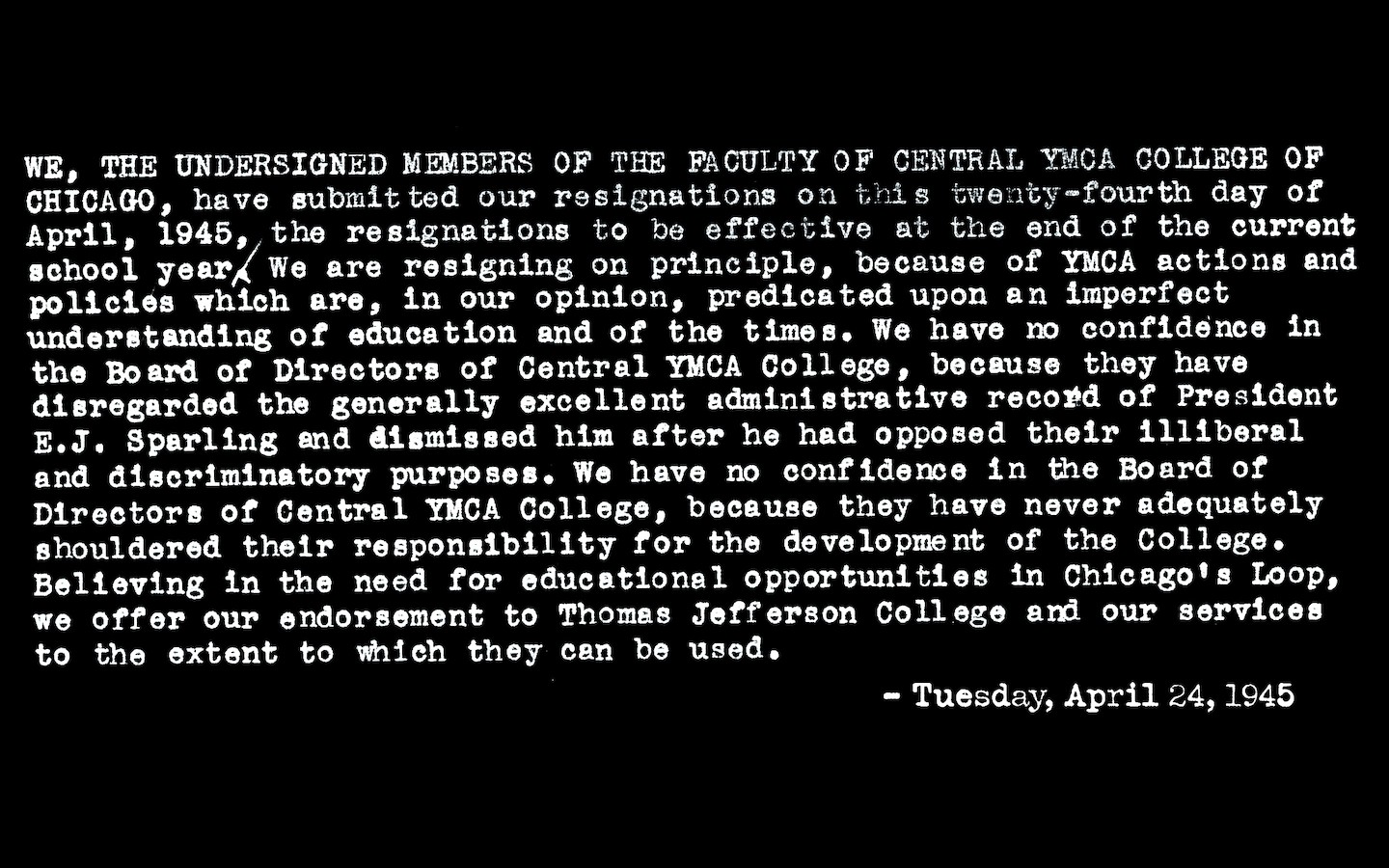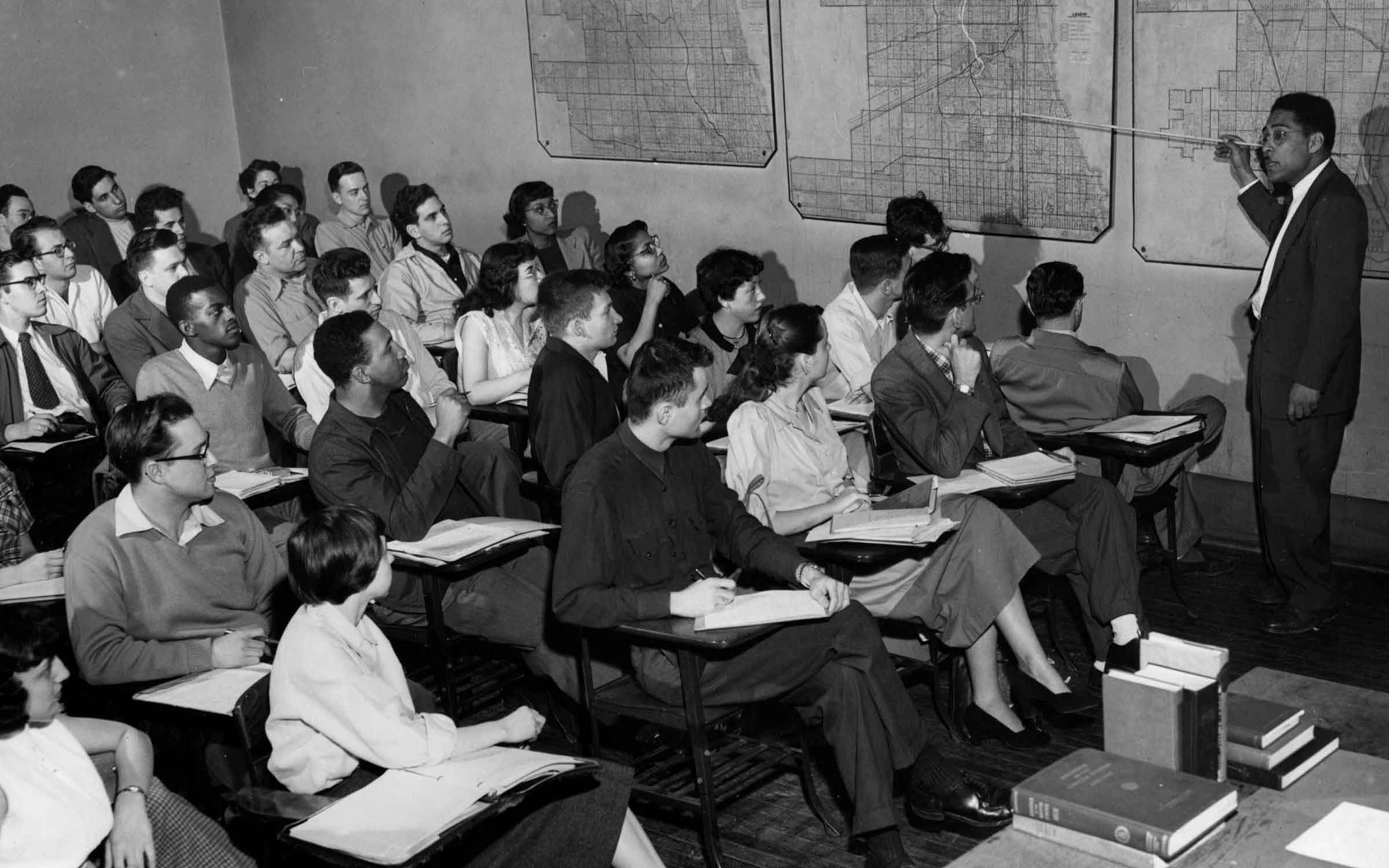
In 1945, Roosevelt College was created in a courageous effort to make higher education more democratic. It was born into a world where racial, gender and religious segregation dominated colleges and universities. Fewer than 20% of high school graduates went on to higher education in the 1940s. In Chicago, stores, restaurants, housing and recreation excluded African Americans.
LIMITED COLLEGE CHOICES
Chicago students had limited college choices during the early 1940s. Until 1946, when the University of Illinois opened a two-year campus for first-years and sophomores on Navy Pier, the only comprehensive public university was 140 miles away in Urbana-Champaign. Local options included professional and teacher-training colleges, junior colleges, Catholic schools, the University of Chicago and Northwestern University.
Bigotry further restricted college opportunities. Many private colleges and universities at this time — including Northwestern — imposed admissions quotas on the number of Jewish, Catholic and Black students they would accept. To screen out “socially undesirable applicants,” they required photographs, personal interviews or the names of all four grandparents on applications.
The number of Black enrollees at selective schools was miniscule. Princeton University, for example, would not admit black students until 1945. Public universities also discriminated by race. It was not until 1948 that the University of Arkansas admitted its first African-American student. Northwestern, which did admit up to five black students a year in the 1940s, excluded these students from on-campus housing until 1947.
Jewish students were held to quotas of between 2 and 15% as universities responded to what they termed the “Jewish problem.” These discriminatory admission policies, which had begun in the 1920s, persisted until the mid-1960s.
THE CENTRAL YMCA COLLEGE
One exception was the Central YMCA College in Chicago. Opened in 1919, by 1941 it enrolled a diverse group of 2,240 men and women and identified itself as “liberal in spirit.”
By the early 1940s, however, the Y’s 16-member Board of Directors — comprised mostly of local businessmen and bankers — had grown uneasy with the rising numbers of “undesirable” Black and Jewish students in the classrooms and hallways. They feared these students would drive away white Protestant applicants.
Despite the “liberal spirit” of the school, there were rigid racial restrictions in place. Black students, for instance, were expected to pay athletic fees but weren’t permitted to use the swimming pool, which was operated by the YMCA.
The president of the college was Edward “Jim” Sparling. A Stanford-educated psychologist, he arrived at the Y College in 1936 and found himself in increasing conflict with the YMCA over three major issues: admissions quotas, discrimination and academic freedom.
When the Board told Sparling to prepare a census of the racial and religious composition of the student body, he refused, saying, “We don’t count that way.” In February 1945, he was told to resign.
A NEW KIND OF UNIVERSITY
President Sparling and his supporters immediately lobbied for a “friendly separation” from the YMCA and planned a new school — initially called Thomas Jefferson College — that would offer admission and equal rights to any qualified student. They sought financial backing from Marshall Field III, the Rosenwald Foundation, labor unions and progressive Chicagoans.
When efforts to interest the Y in this project failed, Sparling formally resigned on April 17, 1945. In a walkout surely unique in American higher education, 62 faculty members resigned in his support and signed a document condemning the “illiberal and discriminatory purposes” of the Board. A student resolution soon followed, favoring separation from the Central YMCA College by a vote of 448 to 2.
President Franklin Roosevelt had died on April 12 and two weeks later the new school was renamed Roosevelt College.
Edwin R. Embree, a friend of FDR, head of the Rosenwald Foundation and first chair of Roosevelt’s Board of Trustees, said the new school “embodies the democratic principles to which President Roosevelt gave his life — the four freedoms in action . . . Roosevelt College of Chicago will practice no discrimination in students or faculty and no restriction of class or party line in its teaching or research.”
THE TWO-MONTH SCRAMBLE
The College now had a mission, a name, a faculty and students, but no money, classrooms, labs or library. The new Board of Trustees, which included African American chemist Percy Julian, was undoubtedly one of the first racially integrated college boards. It took the trustees until mid-July to acquire a home, an 11-story office building on Wells Street, and a lease on a second building on Wabash Avenue for a music school.
The Board then had two months to raise money, remodel offices into classrooms, studios and labs, and plan for fall classes. They bought chairs from Standard Oil, lab equipment from Illinois Technical College, and books, desks and blackboards from a variety of sources. Faculty and students pushed carts piled high with books and supplies through city streets to set up the new campus. They worked alongside painters and carpenters to ready the classrooms for the fall semester.
At the same time, Roosevelt College leaders were busy creating one of the most diverse faculties in the United States. In an era when most American professors were white male Protestants, Roosevelt hired men, women, African Americans, Jews, European refugees, Catholics and teachers from India, China and Latin America.
Founding faculty members:
- Political scientist Tarini Prasad Sinha
- Sociologist Rose Hum Lee
- Economist Abba Lerner
- Philosopher Estelle De Lacey
- Language professor Dalai Brenes
- Sociologist St. Clair Drake
- Chemist Edward Chandler and many more.
The faculty grew to 71 full-time and 90 part-time professors by 1946. An additional 1,000 professors from around the country sent applications hoping to work at this pioneering college, even if it meant a cut in pay.
ST. CLAIR DRAKE TEACHES AN EARLY CLASS OF ROOSEVELT STUDENTS
CHICAGO’S EQUALITY LAB
Approximately 1,200 students began classes on Sept. 24, 1945. They were even more diverse than the faculty —described by one newspaper as “Chinese, Japanese, Negroes, Levantines, Jews, Catholics and Down East Yankees.”
The next year, realizing the first campus was too small to accommodate the number of students seeking admission, Roosevelt acquired Chicago’s famed Auditorium Building on Michigan Avenue. Five thousand students, from military veterans to new high school graduates, registered for classes in the fall of 1947.
And so a new college began. Magazine and newspaper reporters flocked to the classrooms and marveled at Chicago’s “equality lab.” In November 1945, Eleanor Roosevelt, chair of Roosevelt’s advisory board, dedicated the college “to the enlightenment of the human spirit.” A remarkable act of courage in the spring of 1945 had created, as one journalist wrote, nothing less than “a model of democracy in higher education.”
Author Lynn Weiner is a professor of history emerita at Roosevelt University. This article was originally published as “The Equality Experiment” on June 10, 2015. Updated April 8, 2021.
